Which came first, The Chipmunks or the Mouse Musicians? Walt Disney’s very own idea for a Christmas record didn’t take the world by storm. But a year later, when one of the biggest novelty hits used basically the same technique… was it coincidence?
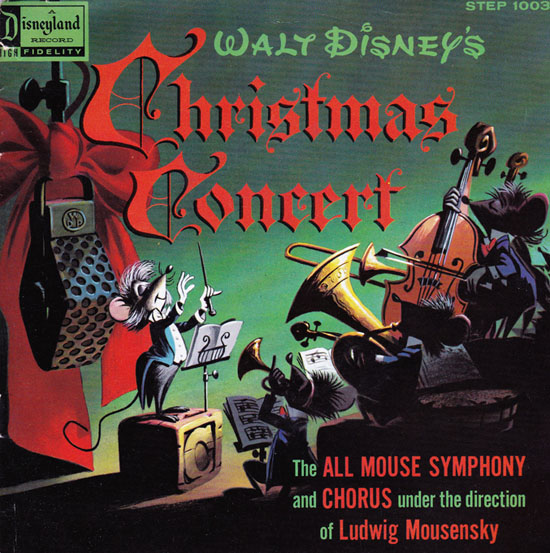
WALT DISNEY’S CHRISTMAS CONCERT
Ludwig Mousensky and the All-Mouse Symphony and Chorus
Disneyland Records STEP-1003 (7” 45 rpm EP with Booklet / Mono)
Released in 1957. Executive Producer: Jimmy Johnson. Producer/Arranger/Conductor: Camarata. Songs: Felix Bernard, Richard B. Smith, Traditional. Running Time: 10 minutes.
Voices: Jimmy Macdonald (Ludwig Mousensky, Assorted Mice); Singers likely to include Gloria Wood, Thurl Ravenscroft and Bill Lee (Mouse Chorus).
Songs & Carols: “Jingle Bells,” “Winter Wonderland,” “Hark! The Herald Angels Sing,” “O Little Town of Bethlehem,” “O Come All Ye Faithful.”
When Walt Disney’s first in-house record company, Disneyland Records, started up in the spring of 1956, he was engrossed in such other projects as Disneyland Park, Sleeping Beauty and television shows. Disneyland Records President Jimmy Johnson, in his much sought-after 1975 autobiography, Inside the Whimsy-Works: My Life with Walt Disney Productions (which will at last be by published by University Press of Mississippi this February), recalled the inside story:
In the first year of the record company, Walt hadn’t taken any interest in what we were recording, but in the summer of 1957, he came up with an idea for a Christmas record.
“You see,” he said, “there’s this bunch of mice who live in the basement of a recording studio. They sing, they play instruments, and when everybody goes home at night, they make records. We can use the speed-up voice technique we used for the mice in Cinderella.”
“Professor Ludwig Mousensky and his All-Mouse Orchestra and Chorus” came into being and Tutti [Camarata] and I went to work recording them. By speeding up the tape, the regular voices of ordinary singers become squeaky and mouse-like. We used the speed-up on the orchestra, too. We recorded Jingle Bells and three Christmas carols with the mouse chorus and orchestra, plus a flamboyant mouse instrumental version of Winter Wonderland.
Using the speed-up technique involves a great deal of hard and painstaking work but we finally came up with a record. When I played it for Walt he was disappointed.“I’ve never known a musician with a sense of humor,” he said, and dismissed the matter from his mind.
We released the record during the Christmas season of 1957, complete with a little booklet filled with drawings of all the mouse musicians. The record made a few dollars, but it was not a big hit.The next Christmas, Ross Bagdasarian released his first Chipmunk record, The Chipmunk Song, on the Liberty label. He also used the speed-up technique for the voices of the Chipmunks. The Christmas season is a short one for record sales but Liberty did the impossible and sold over four million records between the middle of November and the middle of January. It was one of the biggest Christmas hits ever.
There was one small, but very important, difference between the Chipmunk record and our mouse record of the year before. At the very beginning of the Chipmunk record Ross Bagdasarian says in a straight voice, “All right you Chipmunks, ready to sing your song?” Thus the speeded-up voices were immediately identified as chipmunks. We forgot to immediately identify ours on the record as mice. Walt never forgave me for allowing Ross to scoop us on his idea.
While Walt’s comment about “a musician with a sense of humor” might seem curt, it’s not necessarily a slight of trusted musical director Tutti Camarata or the real-life musicians, but a statement about why the project disappointed him. The resulting recording tried to make a very large group of mouse musicians funny—a daunting task left unfulfilled, despite the presence of a few cut-ups within the musical mouse ensemble.
The booklet’s illustrations – which, though not verified, appear to be the work of story artist Bill Peet – hint at hijinks that might been incorporated into the recording. (The booklet images are posted below – click thumbnails to enlarge) The art resembles storyboard gag sketches for an animated film (which could have been considered had the project pleased Walt).
However, the book identifies even more mice than the record does and the gags get lost in the crowd. Cinderella had lots of mouse friends too, but the focus was on Jaq, Gus-Gus and Suzy. Christmas Concert lacked that focus, as Johnson realized.
Musically, Christmas Concert is spectacular. Camarata’s arrangements are wildly imaginative, employing every bit of the skill he employed when he created the famous tempo changes on Jimmy Dorsey’s hit big band records. The orchestra itself sounds a little speeded-up too, something that Bagdasarian did not do on his records.
I’ve found no confirmation as to whether Bagdasarian listened to Walt Disney’s Christmas Concert before he created Alvin and The Chipmunks. The following Summer brought his first big hit, “Witch Doctor” (Ooh-Ee-Ooh-Ah-Ah), with only one speeded-up voice that was not a chipmunk so much as the witch doctor himself. But by fall 1958, the release of “The Chipmunk Song” cemented the three personalities in seconds.
Speeded-up voices were nothing new in the 1950s. The voices of the aforementioned mice in Cinderella were created that way, as were several of Mel Blanc’s roles in Warner Bros. cartoons, Pinto Colvig’s Gabby in Fleischer’s Gulliver’s Travels and many more. Even Thomas Edison’s squeaky recording of “Mary Had a Little Lamb” makes one wonder if he and his staff recognized the effect at the very dawn of recording.
Whatever the complete truth might be, great minds often think alike.
GIVE A LITTLE LISTEN
Introduction to “Winter Wonderland” & Intro to “The Chipmunk Song”
Ludwig Mousensky (with two different accents) warms up the orchestra for a show-stopping rendition of “Winter Wonderland,” as several mice practice their sections and/or mess things up. Six mice are mentioned by name: Hans, Fritz, Otto, Squeeky, Zeke and mischievous Pinky. Additional mouse musicians in the book include Horace, Henrietta, Tubby, Tootie (a nod to Tutti?), Clarence, Stuffy, Zooty, Pee Wee and Frenchy.
Within seconds of the start of “The Chipmunk Song,” we know Alvin, Simon, Theodore and David Seville (whose name is on the label if not in the song). A multi-million-dollar entertainment phenomenon was born. Of course, Walt Disney had already had several such phenomena with more on the way.

WALT DISNEY’S CHRISTMAS CONCERT (Reissue)
Mickey Mouse and the All-Mouse Chorus
Disneyland Records DBR-47 (7” 45 rpm EP / Mono)
Released in 1959. Executive Producer: Jimmy Johnson. Producer: Camarata. Arranger/Conductors: Camarata, Buddy Baker. Running Time: 11 minutes.
Songs & Carols: “Hark! The Herald Angels Sing,” “O Little Town of Bethlehem,” “O Come All Ye Faithful,” “Jingle Bells,” “Kris Kringle,” “From All of Us to All of You.”
Voices: Jimmy Macdonald (Mickey Mouse, Goofy); Cliff Edwards (Jiminy Cricket); Singers likely to include Gloria Wood, Thurl Ravenscroft and Bill Lee (Mouse Chorus).
The selections from 1957’s Christmas Concert were repurposed for at least a dozen subsequent Disney albums, singles and read-alongs. This particular one cleverly eschews Ludwig Mousensky for the way-more-famous Mickey Mouse as the presenter.
As Mickey, Jimmy Macdonald (whose Mickey always sounds like Mister Moose to me) introduces the public domain All-Mouse Symphony selections (“Winter Wonderland” is copyrighted), as well as Edwards’ “Kris Kringle” and the title song from the 1958 Disneyland holiday themed TV episode, From All of Us to All of You.
GIVE A LITTLE LISTEN
Ludwig Mousensky Intro & Mickey Mouse Intro to “Christmas Carol Medley”
It’s kind of neat to compare and contrast the two performances of Jimmy Macdonald in two different roles. In Mickey’s case, it sounds to me as if his lines were read in one or two takes on the fly.
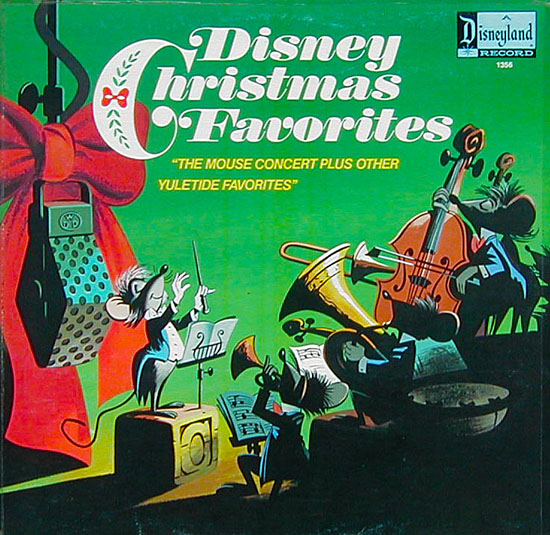
DISNEY CHRISTMAS FAVORITES
The Mouse Concert Plus Other Yuletide Favorites
Disneyland Records 1356 (12” 33 rpm LP / Mono)
Released in 1973. Executive Producer: Jimmy Johnson. Producer: Camarata. Arranger/Conductors: Camarata, Buddy Baker, Brian Fahey. Running Time: 25 minutes.
Performers: Jimmy Macdonald (Mickey Mouse, Goofy); Cliff Edwards (Jiminy Cricket); Louis Prima, Gloria Wood, Thurl Ravenscroft, Bill Lee, The Mike Sammes Singers.
Songs & Carols: “Jingle Bells,” “Winter Wonderland,” “Hark! The Herald Angels Sing,” “O Little Town of Bethlehem,” “O Come All Ye Faithful,” “Kris Kringle,” Rudolph, the Red-Nosed Reindeer,” “Kris Kringle,” “Jolly Old Saint Nicholas,” “Senor Santa Claus,” “Jingle Bones.”
Poem: “The Night Before Christmas.”
Over 15 years after their debut, Johnson put Ludwig Mousensky and the All-Mouse Symphony and Chorus on the cover of an LP record with several sketches from the booklet on the back cover. The entire 1957 recording takes up Side One, while Side Two is actually a direct pick-up from Side One of a 1968 Disneyland album, Favorite Songs of Christmas Featuring Rudolph the Red-Nosed Reindeer.
Ludwig and friends continued to pop up once in a while on various Disney records, like 1976’s Jingle Bells Little Golden Book & Record, for example. But the musical mice never recorded again, nor did they star in a holiday TV special. Otherwise, like most other animated characters, they would have inevitably saved Christmas.
GIVE A LITTLE LISTEN
Rudolph, the Red-Nosed Reindeer – The Mike Sammes Singers
This is a rare stereo version from a Time-Life CD set called Disney Christmas Collection. I love the smooth, distinctive, pitch-perfect sound of The Mike Sammes Singers, who sang with the biggest stars of the mid-20th century. They recorded “Rudolph” at London’s Abbey Road Studios, where they also backed up The Beatles in “Good Night” and “I Am the Walrus.” The singers can be heard in countless other TV shows and movies, included several Rankin/Bass specials.


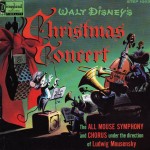
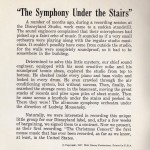

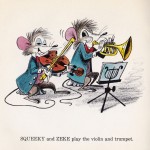
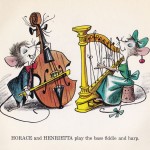
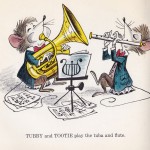


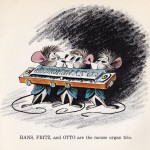
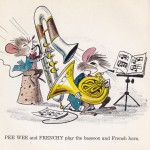

 GREG EHRBAR is a freelance writer/producer for television, advertising, books, theme parks and stage. Greg has worked on content for such studios as Disney, Warner and Universal, with some of Hollywood’s biggest stars. His numerous books include Mouse Tracks: The Story of Walt Disney Records (with Tim Hollis). Visit
GREG EHRBAR is a freelance writer/producer for television, advertising, books, theme parks and stage. Greg has worked on content for such studios as Disney, Warner and Universal, with some of Hollywood’s biggest stars. His numerous books include Mouse Tracks: The Story of Walt Disney Records (with Tim Hollis). Visit 





















































Another important difference between Disney’s All-Mouse Symphony and Chorus and Bagdasarian’s Chipmunks is that Disney’s 15 mice are virtually indistinguishable, except for Professor Ludwig and the one woman mouse. Simon, Theodore, and Alvin stood out from each other from the start, originally by the large S, A, and T on their red pajamas on the cover of their first record, then by the different visual character designs on later records. Also, three individuals can be successfully individualized. 15, even with different names, is just a mob.
Myron Waldman at the Fleischer Studio in Miami did a whole cartoon based on the sped-up voice gimmick, with 1940’s “Ants in the Plants“, so the idea of getting comedy out of very small characters having very high-pitched voices had been around for quite a while by the time these Christmas records rolled out.
I am amazed to learn that the Disney Mouse Concert came before the Chipmunks! I knew it was released in the late 50’s, so I naturally assumed it was a follow-up to the incredible popularity of the Chipmunk Song. It seems derivative, somehow.
I am also amazed to learn that Walt himself had the idea, since by that time so many Disney projects were being developed by so many different creative minds. I wonder if he also created the character of “Ludwig Mousensky”? He must have been fond of the name “Ludwig” as the character “Ludwig Von Drake” made his debut just a few short years later.
The 1973 release was one of my favorite records growing up. I had written a letter to Disneyland Records the year previously with a suggestion for a Christmas album, which they welcomed but never used. They sent me a copy of “Mickey Mouse–This is My Life” as a reward for my suggestion. At the time, there were no Disney Christmas records on the market, and had not been for several years–however, by the end of that year, four Christmas albums were released (or re-released): the Christmas Concert album referenced above, an album of Christmas carols subtitled “From All of Us to All of You,” “A Christmas Adventure in Disneyland,” plus an apparently new release of a Christmas sound effects album. I remember them all vividly because they were all on my “wish list” for that year. I like to think that my letter contributed to the decision to put some Disneyland Christmas albums on the market. My idea, by the way, was to make a record of L. Frank Baum’s short story “A Kidnapped Santa Claus.” Somebody at Disney must have appreciated the thought, even though they never made the album. They wrote me a very nice letter thanking me, plus, as I mentioned, a free record.
Walt Disney may have had the name “Ludwig” on the brain then, since he had just opened Disneyland dominated by Sleeping Beauty’s palace copied from Bavarian King Ludwig II’s 1880s Neuschwanstein Palace.
I bought all three 1973 records too and love them, especially “A Christmas Adventure in Disneyland,” which I hope to cover in a future “Animation Spin.” “This is My Life” is an interesting album too.
Interesting that Bill Peet did the mice illustrations for the record as according to his own autobiography, he storyboard most of the mice sequences in “Cinderella”.
Jimmy Macdonald (whose Mickey always sounds like Mister Moose to me)
Who or what is/was “Mister Moose”?
Mister Moose was a puppet on the Captain Kangaroo show, cheerfully tricking the Captain with gentle jokes that always ended with flurry of ping pong balls. His voice, while not particularly mooselike, registered as a shade older and lower than Mickey’s.
Oh, Dave, Dave, Dave!
Your comment made me feel like I was aging into a rotting corpse the way that guy did when he drank from the wrong grail in “Indiana Jones and the Last Crusade.”
Mister Moose, along with Bunny Rabbit, Dancing Bear and Grandfather Clock, were the beloved puppet residents of the Treasure House on TV’s “Captain Kangaroo” show.
Watch this from about 2:00 to hear his voice:
http://www.youtube.com/watch?v=__0nVHr4bjk
Here’s Family Guy’s reference:
http://www.youtube.com/watch?v=84zW6WmaSJQ
How soon we forget Greg, of course I’m in my late 30’s but I knew what you meant there.
By the mid 1950s Walt Disney apparently had forgotten one of his own previously most memorable career lessons in that emphasis on a few select personalities in a short cartoon over a horde of characters yields not only a better result but box office gold. With the forgettable, run of the mill “Father Noah’s Ark,” Disney animated crowds of characters and none were memorable. With the megabit “The Three Little Pigs” he focused on mainly three, not counting the Big Bad Wolf. Despite his disparaging remark about musicians lacking humor (surely Walt must have met humorist and musician Spike Jones, as he recorded “Der Furher’s Face” during WWII) Walt was the one to blame for letting this potential bonanza slip through his fingers, not the composer nor the conductor. Walt may have thought that his concept alone – a sped up orchestra of mice – was enough to make it work. As an entertainer and producer, he should have remembered that he in fact did know better.
Chip and Dale did one cartoon that showcased speeded-up musical numbers: “Two Chips and a Miss,” 1952. Since the heroes performed with a girl chipmunk, you can argue that the Disney studio produced the ORIGINAL Three Chipmunks musical act.
Evidently that cartoon didn’t excite anybody. It was the first time Chip and Dale dressed up in clothes and occupied a “humanized” world; and I think it was the last until the “Rescue Rangers” TV series. I don’t recall musical interludes of note in any other Chip and Dale cartoon, excepting “I’m Chip; I’m Dale” on an early Disneyland hour. Were there any Chip and Dale records?
So, “Two Chips and a Miss” used two popular characters to put the concept on theater screens nationwide, and didn’t make an undue splash. A few years later, Bagdasarian, evidently inspired by a gimmick he used in the Witch Doctor song, worked up a different set of personalities and a fresh comedy song. He scored. It was a matter of the right chipmunks at the right time.
Dbenson,
There were several Chip ‘n Dale records on the Disneyland label, including “Chipmunk Fun” and “Little Toot & Sailor Songs” on LP. They sang the “I’m Chip” song on the LP, “Donald Duck and His Friends.” All of this material was also released on any number of 45 rpm singles. That doesn’t include Little Golden Records, which also featured Disney Characters, especially on the earliest ones.
It’s interesting that Disney’s “mouse” voices were sped-up at what sounds like the same rate as Ross Bagdasarian/ David Seville’s “chipmunks;” I recall Disney’s own Chip ‘n’ Dale being played at a notably higher speed. It was always difficult to get understandable dialogue out of Chip ‘n’ Dale; while Alvin and his brothers were quite legible.
Fred Patten is right about the personality angle too; even in this first record, Simon is established as a brainy nerd who uses big words, Theodore as a goofy giggler, and Alvin the wise-guy troublemaker; with “Dave” as a basically nice guy pushed to the limit by the antics in the recording studio. You had the whole comic set-up right there.
Ross Bagdasarian, Sr. made a number of lounge-style instrumental records for Liberty, including a minor hit “Armen’s Theme” named for his wife, (incidentally, they’re well worth a listen,) and actually recorded two rejected versions of the “Chipmunk Song” melody; one an instrumental, another a choral version titled “In A Quiet Village Park.” Part of the scrapped instrumental version may be heard in the “Alvin Show” cartoon segment of the song. Many of the original Chipmunk singles feature other Bagdasarian instrumentals as “flip sides.”
I love “Armen’s Theme!” There are at least three albums of his non-Chipmunks music on Liberty Records. It’s also cool to watch Hitchcock’s “Rear Window” to see him in the bottom left apartment as the composer.
While we’re on the subject of Disney Christmas records, I’d still like to know who’s voicing Goofy in the song “From All of Us to All of You”.
http://www.youtube.com/watch?v=kjHdkQUhjBg
Brandon,
That is Jimmy Macdonald too. You can hear him do a similar voice as Willie the Giant on the Disneyland Storyteller of Mickey and the Beanstalk with Robie Lester.
That particular recording was reissued several times without the Goofy section, especially in later years. I don’t know if it was because it doesn’t sound all that much like Goofy, or just that the lyric is kind of weird (“I’ll hang you on my Christmas tree, you’ll be a pretty bangle.”)